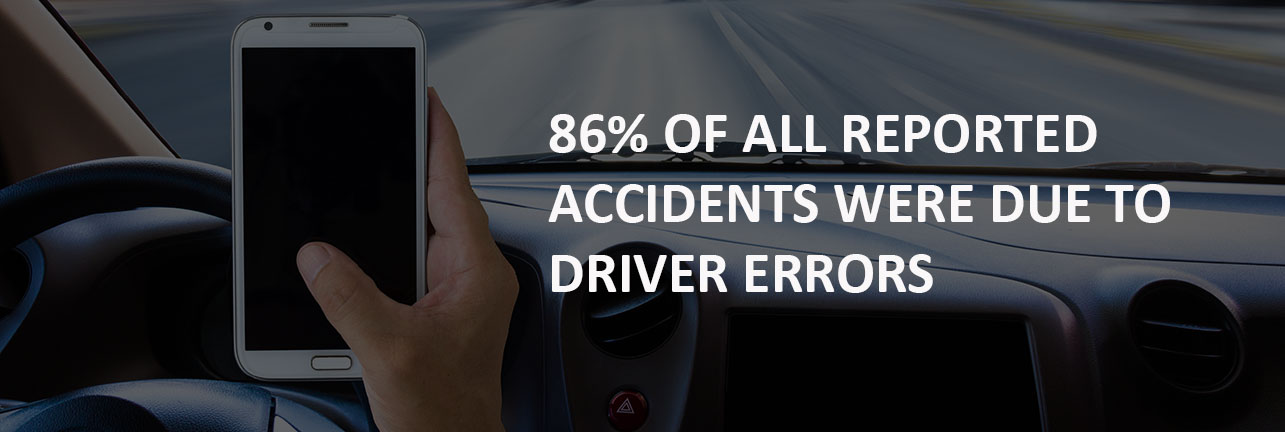Learning Zone
5 top tips to create better drivers within your fleet
Creating better, safer drivers not only minimises the risk of accidents and injuries but also reduces costs too. We look at how you can create better drivers.
Did you know that it is your drivers that are the primary cause of most accidents, not the vehicles that they are driving?
Safety effects the entire business – vehicles, maintenance, operations, and of course your drivers, however, despite advancements in technology to improve vehicle safety, the number one cause of accidents is the driver.
According to the Department of Transport, vehicle defects only account for around 2% of road accidents in Great Britain. Failing to look properly caused the highest number of accidents (42%) followed by failing to judge the speed of oncoming traffic (22%) and careless or reckless driving when in a hurry (18%).
86% of all reported accidents were due to driver errors.
Need more convincing?
What’s clear is that safety needs to begin with drivers, and implementing these five techniques will help to improve performance and create better drivers:
1. Identify behaviours that increase risk
Unsurprisingly, distracted driving is high on the list.
Despite the law change in March 2017 which now makes it an offence to operate an electronic device such as a mobile phone and even going ‘hands free’ considered a distraction.
A survey carried out by the RAC as part of their ‘Be Phone Smart’ campaign found that despite the law, 23% admit speaking illegally on a handheld phone and 15% say that the new penalties hasn’t made them stop.
Also, not a surprise is that electronic devices such as mobile phones are one of the most common distractions for drivers. Attentiveness to driving when using a device, either hands free or handheld, has an adverse effect on reaction time, speed, following distance and lane position.
Alcohol is another contributing factor towards transportation accidents and fatalities. This is closely followed by issues relating to the legalisation of marijuana, the increased use of synthetic drugs and the dramatic rise in over-the-counter prescription and medication abuse.
Fatigue can also be just as deadly as alcohol and drug impairment. Fatigue regularly causes accidents which are preventable if drivers, including commercial vehicle operators, don’t get adequate rest.
.
2. Educate your drivers
Eliminating distractions in transportation requires change in driver thinking and behaviour – each of these easily preventable issues identified can be effectively addressed with fleet driver training.
Training is one of the most effective techniques for creating better drivers. Engaging drivers in education makes them aware of the dangers of distracted, fatigued and impaired driving.
Fleet driver training can play an important part in mitigating claims of negligence when an accident does occur. In most accident litigation, solicitors focus on the risks taken by your drivers with the burden of proof falling on your company to show not only compliance with training mandated by law, but also the training procedures you have in place.
3. Adoption of your company policies
Company policies relating to the safe operation of vehicles establishes a uniform understanding of your expectations.
A good example is a policy that covers mobile phone use (or the use of any mobile electronic device) while operating a company owned, leased or personal vehicle on company business. Similarly, a policy that requires drivers to be medically fit ensures that they have suitable health and fitness levels before driving a company vehicle.
4. Enforce the rules
A policy can only be effective if it is backed by the enforcement of real and established consequences for non-compliance. Drivers won’t alter their unsafe driving practices simply because a policy is in place. It’s up to your Fleet Managers to enforce policies, regardless of any challenges or resistance in doing so.
In some instances, there can be costs associated with failing to implement and enforce a company policy.
5. Improve performance with data management
The key to creating better drivers is to improve performance. To improve performance it is important to measure.
The ability to store driver information enables easier reporting on accident rates and behavior which in turn helps identify risk and reduce costly repairs, vehicle downtime and insurance premiums. Having a system in place that enables you to understand the causes of safety challenges means a better chance in finding and implementing possible solutions.
Data can also be used to help analyse risk, develop effective policies and procedures, identify training needs and ensure compliance. Fleet driver management software keeps your driver records up-to-date, organised and easily accessible for these purposes.
Reducing costs and improving driver safety are not mutually exclusive, however encouraging safe driving practices can make the difference. Long term, it not only lowers costs but also improves employee satisfaction, company reputation and image.
Ensuring you have a strategy to reduce the risk of road accidents in your fleet should be a priority.






